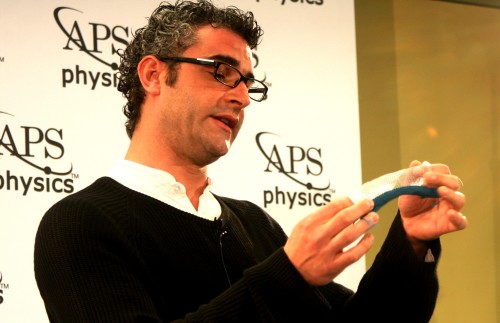Tag archives: everyday physics
The everyday physics of knitting, ribbon-curling and more

Knit stitch: Frédéric Lechenault talks about the physics of knitted materials. (Courtesy: James Riordon/APS)
By Tushna Commissariat in Baltimore, Maryland, US
You may think that a simple occurrence such as a tree shedding its leaves or an everyday activity such as knitting or ribbon-curling does not involve a great deal of physics, but you would be wrong. In a press session here at the APS March meeting entitled “The physics of everyday life”, three different groups of researches talked about the unexpectedly complex physical principles that govern all of the above mentioned instances.
Sunny Jung of the Bio-Inspired Fluid Lab at Virginia Tech in the US studies the shapes of different leaves and the thickness of their “petioles” or stalks – both of which determine the stresses a leaf can withstand on a windy day and what happens when it ultimately falls. Jung’s team studies this because leaves are actually very good at withstanding all kinds of stress and strain without buckling – something that could be applied to large man-made industrial objects such as suspended road-signs.
The researchers found that slender leaves are more likely to bend under high winds, whereas a flat leaf is more likely to twist at the stem before falling. They also discovered that the length of the stalk is determined by the size of the leaf, with larger leaves needing longer stems so that sunlight can cover more of their surface area.